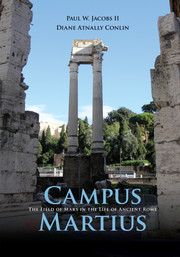Book contents
- Frontmatter
- Contents
- Illustrations
- Acknowledgments
- Maps
- Introduction: “This Place Was Holiest of All”
- Chapter One “The Size of the Plain Is Remarkable”: Defining the Limits of the Campus Martius in Time and Space
- Chapter Two Gathering Troops in the War God's Field
- Chapter Three “Very Costly Temples”: The Campus Martius and Republican Temple Construction
- Chapter Four “Chariot Races,” “Three Theatres,” “An Amphitheatre,” and More: Entertainment in the Campus Martius
- Chapter Five “Colonnades about It in Very Great Numbers”: The Porticoes of the Campus Martius
- Chapter Six Between the Aqua Virgo and the Tiber: Water and the Field of Mars
- Chapter Seven “A Zeal for Buildings”: Reshaping of the Space by the Emperors
- Conclusion: “The Rest of the City a Mere Accessory”
- Appendix A Chronology of Development in the Campus Martius to the Early Fourth Century c.e.
- Appendix B Glossary of Architectural Terms
- Notes
- Selected Bibliography
- Index
- Plate Section
Chapter Seven - “A Zeal for Buildings”: Reshaping of the Space by the Emperors
Published online by Cambridge University Press: 18 December 2014
- Frontmatter
- Contents
- Illustrations
- Acknowledgments
- Maps
- Introduction: “This Place Was Holiest of All”
- Chapter One “The Size of the Plain Is Remarkable”: Defining the Limits of the Campus Martius in Time and Space
- Chapter Two Gathering Troops in the War God's Field
- Chapter Three “Very Costly Temples”: The Campus Martius and Republican Temple Construction
- Chapter Four “Chariot Races,” “Three Theatres,” “An Amphitheatre,” and More: Entertainment in the Campus Martius
- Chapter Five “Colonnades about It in Very Great Numbers”: The Porticoes of the Campus Martius
- Chapter Six Between the Aqua Virgo and the Tiber: Water and the Field of Mars
- Chapter Seven “A Zeal for Buildings”: Reshaping of the Space by the Emperors
- Conclusion: “The Rest of the City a Mere Accessory”
- Appendix A Chronology of Development in the Campus Martius to the Early Fourth Century c.e.
- Appendix B Glossary of Architectural Terms
- Notes
- Selected Bibliography
- Index
- Plate Section
Summary
In late summer, 43 b.c.e., Octavian, then using the self-appointed title of Caesar, rode with his army to the Field of Mars to confront his Senate enemies within the city walls. Much had occurred since his first trip to Rome after his adoptive father's assassination. At that time (late May 44 b.c.e.) he had met in the Campus Martius with Mark Antony in gardens that previously belonged to Pompey the Great in order to claim, unsuccessfully, his inheritance. Now the young Caesar returned in force. Facing legions camped in the mostly open plain, the Senate wisely yielded to Octavian's demands. Donatives were awarded to his men, and Caesar's heir was made consul, allowing him to enter the city as Rome's sanctioned co-leader. While Octavian was performing sacrifices with respect to his election to consul, twelve vultures were seen, according to Appian and Suetonius, the same number that oversaw the laying of the city's foundation by Romulus.
Fifty-seven years later, Octavian, now the emperor Augustus, died. His funeral bier was carried on the shoulders of senators through the Campus Martius to be cremated. The space through which the mourners walked was very different from the field that had housed the young Octavian's troops in 43 b.c.e. A series of buildings now rose parallel to the Via Flaminia: the Diribitorium, Saepta Julia, Thermae Agrippae, Stoa of Poseidon, and Pantheon. The arcades of the Aqua Virgo crossed the main road north. Along the western side of the Via Flaminia stood an altar to Augustan Peace, the Ara Pacis, and nearby an imported Egyptian obelisk dedicated to the emperor's triumph over Antony and Cleopatra cast a shadow along a bronze meridian set in travertine. Numerous temples in the area of the Circus Flaminius were rebuilt and rededicated, and two additional permanent theaters were added.
- Type
- Chapter
- Information
- Campus MartiusThe Field of Mars in the Life of Ancient Rome, pp. 138 - 164Publisher: Cambridge University PressPrint publication year: 2015



